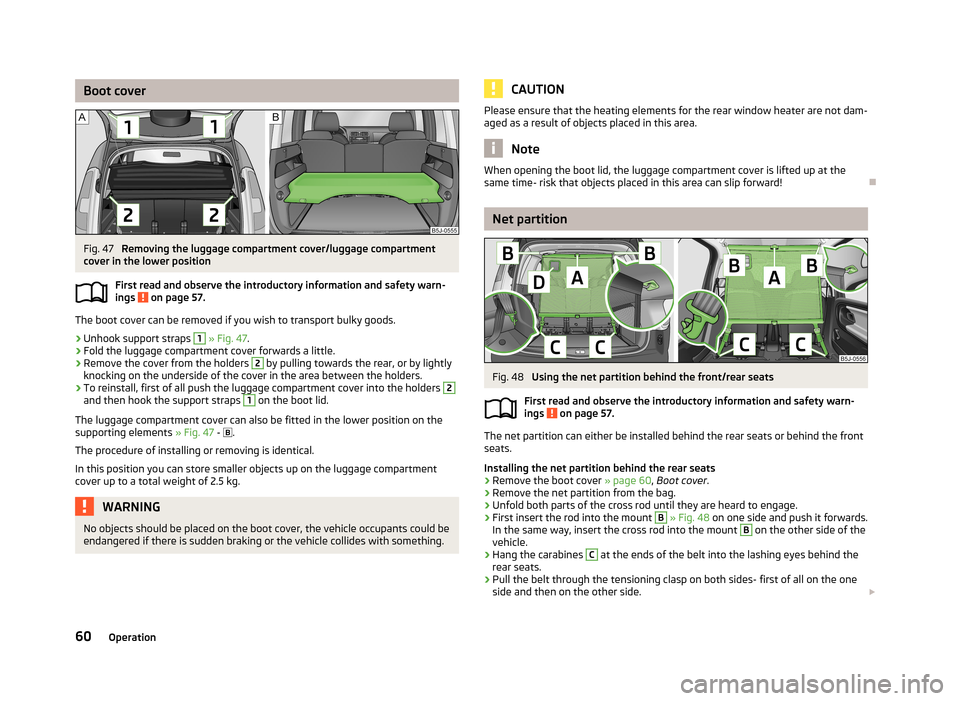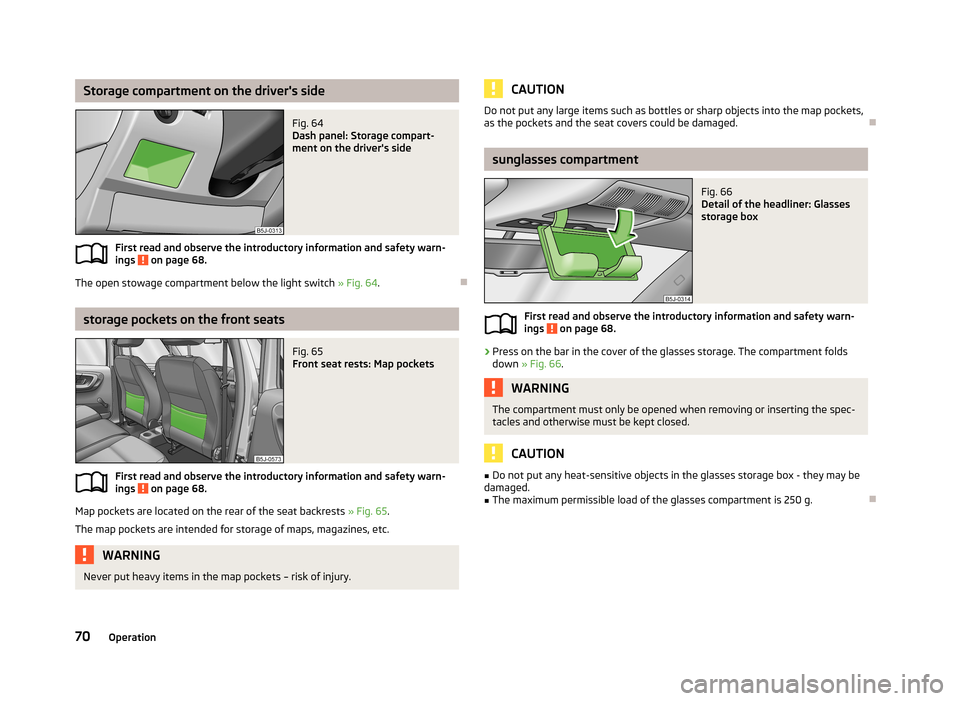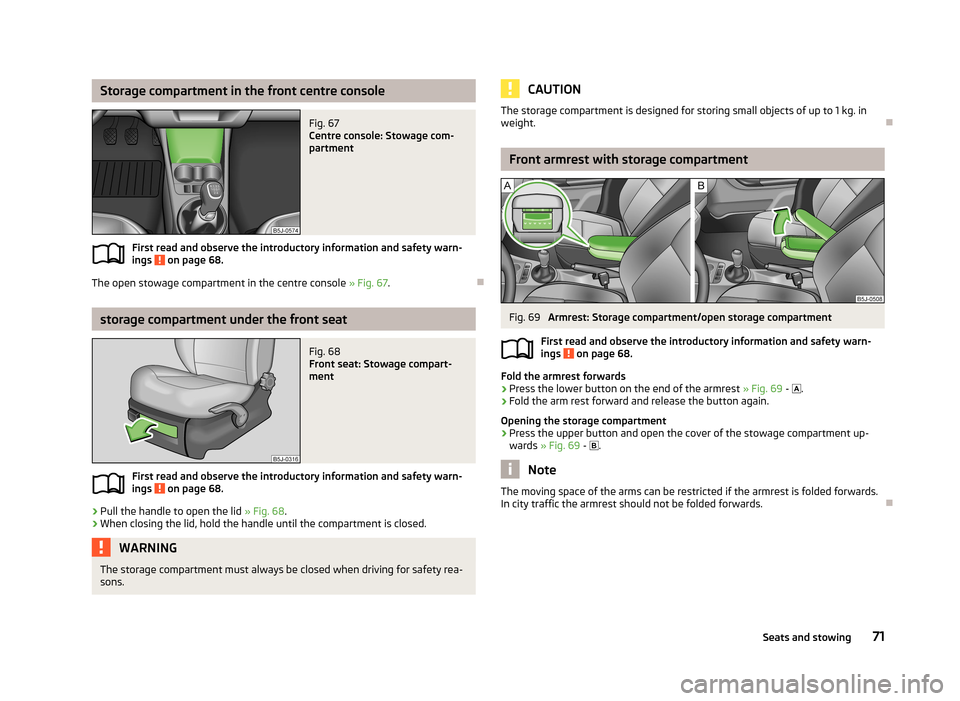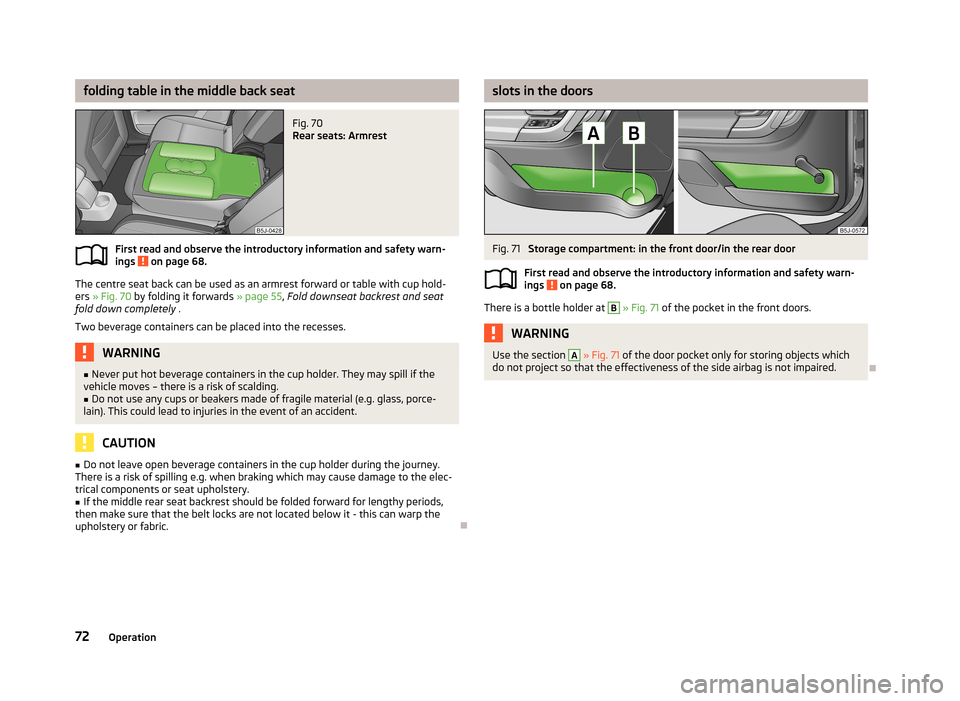2013 SKODA ROOMSTER fold seats
[x] Cancel search: fold seatsPage 63 of 219

Boot coverFig. 47
Removing the luggage compartment cover/luggage compartment
cover in the lower position
First read and observe the introductory information and safety warn-
ings
on page 57.
The boot cover can be removed if you wish to transport bulky goods.
›
Unhook support straps
1
» Fig. 47 .
›
Fold the luggage compartment cover forwards a little.
›
Remove the cover from the holders
2
by pulling towards the rear, or by lightly
knocking on the underside of the cover in the area between the holders.
›
To reinstall, first of all push the luggage compartment cover into the holders
2
and then hook the support straps
1
on the boot lid.
The luggage compartment cover can also be fitted in the lower position on the
supporting elements » Fig. 47 -
.
The procedure of installing or removing is identical. In this position you can store smaller objects up on the luggage compartment cover up to a total weight of 2.5 kg.
WARNINGNo objects should be placed on the boot cover, the vehicle occupants could be
endangered if there is sudden braking or the vehicle collides with something.CAUTIONPlease ensure that the heating elements for the rear window heater are not dam-
aged as a result of objects placed in this area.
Note
When opening the boot lid, the luggage compartment cover is lifted up at the
same time- risk that objects placed in this area can slip forward!
Net partition
Fig. 48
Using the net partition behind the front/rear seats
First read and observe the introductory information and safety warn-
ings
on page 57.
The net partition can either be installed behind the rear seats or behind the front
seats.
Installing the net partition behind the rear seats
›
Remove the boot cover » page 60, Boot cover .
›
Remove the net partition from the bag.
›
Unfold both parts of the cross rod until they are heard to engage.
›
First insert the rod into the mount
B
» Fig. 48 on one side and push it forwards.
In the same way, insert the cross rod into the mount
B
on the other side of the
vehicle.
›
Hang the carabines
C
at the ends of the belt into the lashing eyes behind the
rear seats.
›
Pull the belt through the tensioning clasp on both sides- first of all on the one side and then on the other side.
60Operation
Page 64 of 219

Removing the net partition›Undo the belts on both sides and unhook the carabiners C » Fig. 48 .›
Push the cross rod first of all on the one side and then on the other side to-
wards the rear.
›
Remove the cross rod from the mounts
B
.
Packing the net partition
›
Press the red button on hinge
A
» Fig. 48 - the hinge breaks.
›
Put the net partition folded together in the bag and close it.
›
Attach the bag with the aid of the plastic carabines to the eyes on the left and
right boot trim panel.
Installing and removing the net partition behind the rear seats is carried out anal-
ogously as behind the rear seats. Use the lower fixing eyes on the carrier rails in
order to attach the carabines. To enlarge the boot, the rear seats can be removed.
Installing and removing the net partition behind the rear seats with variable load- ing floor » page 61 is carried out analogously as behind the rear seats without
variable loading floor. To attach the carabines, use the lower eyes at the fixing
wedges on the front part of the variable loading floor.
The opening
D
» Fig. 48 in the net partition is designed to pass the three-point
seat belt » page 130 , Seat belt for the rear middle seat through.
Variable loading floor in the luggage compartment
(Estate)
Introduction
This chapter contains information on the following subjects:
Dividing up the luggage compartment with variable loading floor
61
Removing and refitting the variable loading floor
62
Removing/installing the carrier rails
62
Removing/installing the lateral carrier rail and fixing wedges
63
The variable loading floor makes handling of bulky items of luggage easier.
CAUTION
The maximum permissible load of the variable loading floor is 75 kg.NoteThe room under the variable loading floor can be used to stow objects.
Dividing up the luggage compartment with variable loading
floor
Fig. 49
Dividing the boot
First read and observe the introductory information and safety warn-
ings on page 61.
›
Lift up the part with the holder and secure it by sliding it into the grooves
marked with the arrows » Fig. 49.
61Seats and stowing
Page 66 of 219

Removing/installing the lateral carrier rail and fixing wedgesFig. 52
Boot: Take out lateral carrier rail/Take out fixing wedges
First read and observe the introductory information and safety warn- ings
on page 61.
Removing
›
Remove the lateral carrier rail » Fig. 52 -
and remove by pulling in the direc-
tion of arrow.
›
Grip the fixing wedge » Fig. 52 -
and remove by pulling in the direction of ar-
row. To remove the fixing wedge on the other side of the luggage compart-
ment, proceed in the same way.
Fitting
›
Put the fixing wedge on the fixing points and press in the direction of the sides
of the luggage compartment up to the stop.
›
Insert the lateral carrier rail at an angle to the fixing wedges and press it up to
the stop.
›
Check how well the lateral carrier rail is fastened by pulling on it.
Bicycle carrier in the luggage compartment
Introduction
This chapter contains information on the following subjects:
Install cross member
63
Install bicycle carrier
64Put bicycle into the bicycle carrier64Secure the stability of the bicycles with a belt64WARNINGWhen transporting bicycles, ensuring the safety of the passengers is para-
mount.
CAUTION
Take care handling the bicycle - there is a risk of damaging the vehicle.
Install cross member
Fig. 53
Install cross member
First read and observe the introductory information and safety warn- ings on page 63.
›
Remove the luggage compartment cover » page 60.
›
Fold the rear seats forward, remove » page 55.
›
Undo the securing bolts
C
» Fig. 53 and remove a little to unlock the holders
B
.
›
Place the cross member
A
with the fixed part onto the right lashing eye and
then place it on the left lashing eye with the removable part of the cross mem-
ber
A
.
›
Press the holders
B
until they latch. Tighten the securing screws
C
.
›
Check how well the cross member is fastened by pulling on it.
63Seats and stowing
Page 71 of 219

■If electrical consumers are switched on when the engine is not running, this will
cause the car battery to discharge – risk of battery discharge!■
Only use matching plugs to avoid damaging the 12-volt power socket.
■
Only use accessories that have been tested for electromagnetic compatibility in
accordance with the applicable directives.
■
Before turning the ignition on or off, and before starting the car, switch off the
device connected to the 12-volt power socket to prevent any damage caused by
voltage fluctuations.
■
Observe the operating instructions for the connected devices!
Clothes hook
First read and observe the introductory information and safety warn-ings
on page 65.
The clothes hooks are located on the handle of the headliner above each of therear doors.
WARNING■ Ensure that any clothes hanging from the hooks do not impair your vision to
the rear.■
Only use the hooks for hanging light items of clothing and ensure that there
are no heavy or sharp-edged objects in the pockets.
■
Do not use clothes hangers for hanging up items of clothing otherwise this
may reduce the effectiveness of head airbags.
CAUTION
The maximum permissible load of the hooks is 2 kg.
Car park ticket holderFig. 61
Windscreen: Parking ticket hold-
er
First read and observe the introductory information and safety warn-
ings on page 65.
The note holder is designed e.g. for attaching car park tickets.
WARNINGThe attached note has to always be removed before starting off in order not
to restrict the driver's vision.
Storage compartments
Introduction
This chapter contains information on the following subjects:
Storage compartment on the front passenger side
69
Cooling the storage compartment on the front passenger side
69
Storage compartment on the driver's side
70
storage pockets on the front seats
70
sunglasses compartment
70
Storage compartment in the front centre console
71
storage compartment under the front seat
71
Front armrest with storage compartment
71
folding table in the middle back seat
72
slots in the doors
72
68Operation
Page 72 of 219

stowage compartments in the luggage73Flexible storage compartment73WARNING■Do not place anything on the dash panel. These objects might slide or fall
down while you are driving (under acceleration or when cornering) and could
distract you from the traffic - there is a risk of an accident.■
Make sure that no objects from the centre console or from other storage
compartments can get into the driver's footwell while you are driving. You
would then no longer be able to apply the brakes or operate the clutch or ac-
celerator pedal – there is a risk of an accident.
Storage compartment on the front passenger side
Fig. 62
Dash panel: Storage compart-
ments on the front passenger
side
First read and observe the introductory information and safety warn- ings on page 68.
Open/close
›
Pull the cover handle in the direction of the arrow » Fig. 62
and fold down the
cover.
›
Lift the lid upwards until it clicks into place.
A pin holder is located inside the lower flap.
WARNINGThe storage compartments must always be closed when driving for safety
reasons.
Cooling the storage compartment on the front passenger sideFig. 63
Storage compartment: Using
cooling system
First read and observe the introductory information and safety warn-
ings on page 68.
›
Use the rotary switch » Fig. 63 to open and close the air supply.
Opening the air supply when the air conditioning system is switched on allows
cooled air to flow into the storage compartment.
Opening the air inlet when the air conditioning system is on causes fresh or inte-rior air to flow into the storage compartment.
We recommend closing the air supply if it is operated in heating mode or the cool-ing system for the storage compartment is not being used.
69Seats and stowing
Page 73 of 219

Storage compartment on the driver's sideFig. 64
Dash panel: Storage compart-
ment on the driver's side
First read and observe the introductory information and safety warn-
ings on page 68.
The open stowage compartment below the light switch » Fig. 64.
storage pockets on the front seats
Fig. 65
Front seat rests: Map pockets
First read and observe the introductory information and safety warn-
ings on page 68.
Map pockets are located on the rear of the seat backrests » Fig. 65.
The map pockets are intended for storage of maps, magazines, etc.
WARNINGNever put heavy items in the map pockets – risk of injury.CAUTIONDo not put any large items such as bottles or sharp objects into the map pockets,
as the pockets and the seat covers could be damaged.
sunglasses compartment
Fig. 66
Detail of the headliner: Glasses
storage box
First read and observe the introductory information and safety warn- ings on page 68.
›
Press on the bar in the cover of the glasses storage. The compartment folds down » Fig. 66 .
WARNINGThe compartment must only be opened when removing or inserting the spec-
tacles and otherwise must be kept closed.
CAUTION
■ Do not put any heat-sensitive objects in the glasses storage box - they may be
damaged.■
The maximum permissible load of the glasses compartment is 250 g.
70Operation
Page 74 of 219

Storage compartment in the front centre consoleFig. 67
Centre console: Stowage com-
partment
First read and observe the introductory information and safety warn-
ings on page 68.
The open stowage compartment in the centre console » Fig. 67.
storage compartment under the front seat
Fig. 68
Front seat: Stowage compart-
ment
First read and observe the introductory information and safety warn-
ings on page 68.
›
Pull the handle to open the lid » Fig. 68.
›
When closing the lid, hold the handle until the compartment is closed.
WARNINGThe storage compartment must always be closed when driving for safety rea-
sons.CAUTIONThe storage compartment is designed for storing small objects of up to 1 kg. in
weight.
Front armrest with storage compartment
Fig. 69
Armrest: Storage compartment/open storage compartment
First read and observe the introductory information and safety warn- ings
on page 68.
Fold the armrest forwards
›
Press the lower button on the end of the armrest » Fig. 69 -
.
›
Fold the arm rest forward and release the button again.
Opening the storage compartment
›
Press the upper button and open the cover of the stowage compartment up- wards » Fig. 69 -
.
Note
The moving space of the arms can be restricted if the armrest is folded forwards.
In city traffic the armrest should not be folded forwards.
71Seats and stowing
Page 75 of 219

folding table in the middle back seatFig. 70
Rear seats: Armrest
First read and observe the introductory information and safety warn-ings on page 68.
The centre seat back can be used as an armrest forward or table with cup hold-
ers » Fig. 70 by folding it forwards » page 55, Fold downseat backrest and seat
fold down completely .
Two beverage containers can be placed into the recesses.
WARNING■ Never put hot beverage containers in the cup holder. They may spill if the
vehicle moves – there is a risk of scalding.■
Do not use any cups or beakers made of fragile material (e.g. glass, porce-
lain). This could lead to injuries in the event of an accident.
CAUTION
■ Do not leave open beverage containers in the cup holder during the journey.
There is a risk of spilling e.g. when braking which may cause damage to the elec- trical components or seat upholstery.■
If the middle rear seat backrest should be folded forward for lengthy periods,
then make sure that the belt locks are not located below it - this can warp the
upholstery or fabric.
slots in the doorsFig. 71
Storage compartment: in the front door/in the rear door
First read and observe the introductory information and safety warn- ings
on page 68.
There is a bottle holder at
B
» Fig. 71 of the pocket in the front doors.
WARNINGUse the section A » Fig. 71 of the door pocket only for storing objects which
do not project so that the effectiveness of the side airbag is not impaired.
72Operation